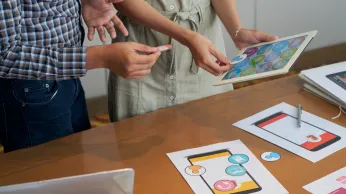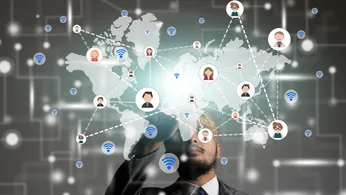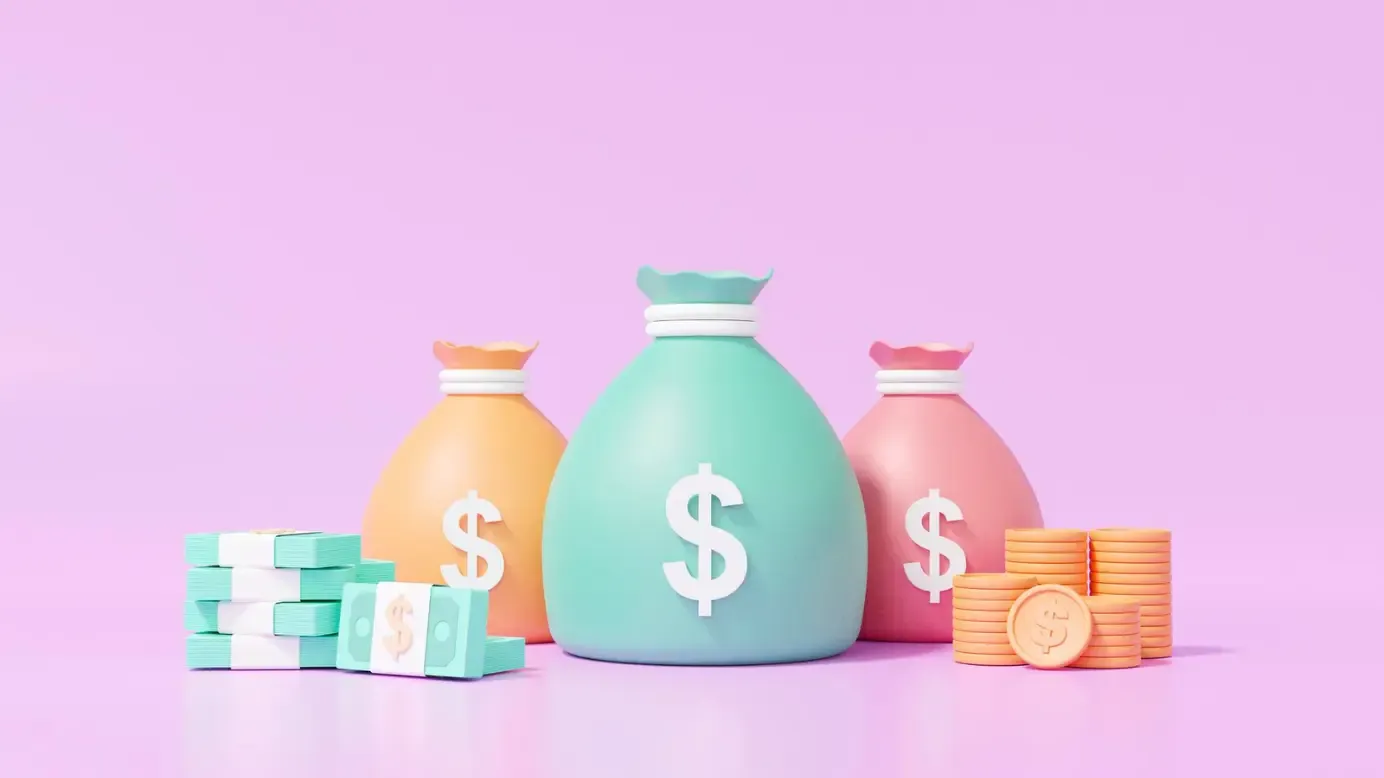7 Best Sales SPIFF Ideas to Motivate Your Sales Reps & Strategies on Running a SPIFF Program
Looking for the best sales spiff ideas to motivate your reps? We've got you covered. From cash bonuses to paid vacations, check out our list of the top sales spiffs to keep your reps motivated and selling.
On this page
Running a successful, growing sales team is not easy, and keeping your team motivated with their eyes on the prize' all year round is crucial. Sales Spiffs ideas for sales reps is one of the best ways to do this. They can boost motivation and keep morale high.
Sales SPIFF is a popular form of incentive. These give instant gratification to your sales reps after closing essential deals. Whether you're just beginning the fiscal year or trying to motivate your sales reps during the year's final quarter, SPIFFs for sales reps can help keep them engaged.
One of the significant advantages of using SPIFF is that it can help reach any sort of goal, whether small or large.
If you're looking for some new ideas to motivate your employees, you're in the right place! So, let's dive into what sales SPIFFs are and give you some good ideas to help motivate your sales team.
What is a SPIFF in sales?
A SPIFF, also known as a ‘spiv’ or SPIF is used by sales teams to describe an immediate bonus for sale. Spiff stands for sales performance incentive fund, also known as a special performance incentive fund.
While it isn’t completely clear where the term comes from, it stands for Sales Performance Incentive Fund - reflecting the idea of a short-term incentive to drive increased sales or exceed some short-term sales goals. Compensation drives sales behavior, ultimately motivating sales reps and improving their performance.
The Pall Mall Gazette wrote a piece on the practices in London shops in 1890. They described SPIFF as “premiums placed on certain articles, not of the latest fashion, indicated by marvelous hieroglyphics put on the price ticket.”
However, the term has evolved into something different today, usually referencing the sale of a specific product.
Sales SPIFF ideas help to promote several different types of incentives or rewards. For example, an employer usually pays these to a member of their team who has sold a specific product. They could also be used to close any gaps in the pipeline, opportunities, or any metric the business needs to improve upon by giving the sales team an extra push!
What are Sales SPIFF programs?
Sales spiff programs are short-term sales campaigns that incentivize the sale of goods or services. Sales spiffs are not compensation plans or are paid on a commission basis.
Instead, the idea behind sales spiffs is to include various perks or incentives to encourage salespeople and channel partners to concentrate most of their efforts on bringing in new business, making more calls, and increasing the total number of deals won.
Difference between sales commission and SPIFF
Both sales commissions and SPIFFs (Special Performance Incentive Funds) are compensation structures designed to motivate sales teams, but they serve different purposes and are structured differently.
While commissions provide a continuous incentive based on sales performance, SPIFFs are short-term bonuses aimed at driving immediate results. Here’s a detailed comparison:
Which one to use?
- Sales commissions are best for maintaining a high-performance sales culture, ensuring sales reps are continuously motivated to close deals.
- SPIFFs are effective for launching new products, clearing inventory, or giving a quick push to underperforming sales figures.
Many companies use both, with commissions forming the core compensation structure and SPIFFs serving as an additional motivator for short-term sales objectives.
Types of SPIFFs in Sales
When taking your first steps towards diversifying your sales spiff incentive ideas, you must consider what form you want these incentives to take. For example, cash or non-cash? A hybrid can often work well, but non-cash rewards are usually more effective!
Getting the right incentives depends on the sales behavior you want to promote. It also depends on how your team responds to various spiff incentives and which ones they prefer.
1. Cash SPIFFs
Cash is an appealing sales incentive as the basis of compensation and commissions. Many individuals are motivated by money because it gives them a choice over what they spend it on. In this sense, it is the most flexible reward of all! Sales Incentives can be rolled out in cash.
SPIFF incentives in the form of cash allow them to spend money as they choose. Of course, a definite amount needs to be declared, and it has to be transparent to keep the entire team in sync.
When putting together your SPIFF scheme, make sure that you separate it from your incentive compensation plan. This ensures that your cash incentive is appealing and worth working for. In addition, this motivates your sales reps to focus on a specific goal and find innovative ways to achieve it.
Usually, a cash incentive is set at a certain amount. For example, a $1,000 bonus for each deal closed during essential times in the financial year, like the end of a quarter. This is particularly effective when your team is known to secure the most deals. It will give them one final push to boost your revenue.
2. Non-cash SPIFFs
On the other hand, cash isn't always king. Some of your team might feel a cash incentive is less personal than the alternatives and aren't as motivated by it as a reward. A non-cash reward leaves room for more creativity in your SPIFF scheme. Non-cash rewards can be incredibly effective, so it's no wonder that about 84% of U.S. companies use them to motivate their employees.
The options for non-cash incentives are endless! For example, you could organize a fine dining experience in a fancy restaurant that might otherwise be difficult. Entertainment tickets for top seats in off-Broadway shows or sporting events can also be equally enticing. These incentives aren't things that your sales team might buy for themselves. Instead, they're more exciting and offer your team something to look forward to!
The nature of these non-cash rewards is dependent on your company and your sales team. What rewards would they enjoy the most? These are just a few examples that might appeal to your team's competitive nature and drive more sales.
It might sound astonishing, but non-cash SPIFFs are gaining traction everywhere. As per the research, 84% of American companies now roll out non-cash SPIFFs to their employees.
The non-cash SPIFF sales incentives include:
- Dine out with the family at a premier restaurant
- Entertainment tickets are available for top seats in a Broadway show or FIFA World Cup. Brittania sent its top sales performers for an all-expense-paid trip to the ICC World Cup. (Source: Economic Times)
- Airbnb, Steelhouse, BambooHR, and many more have vacations to foreign places. (Source: Business Insider)
- Weekend stay at a 5-star hotel with family.
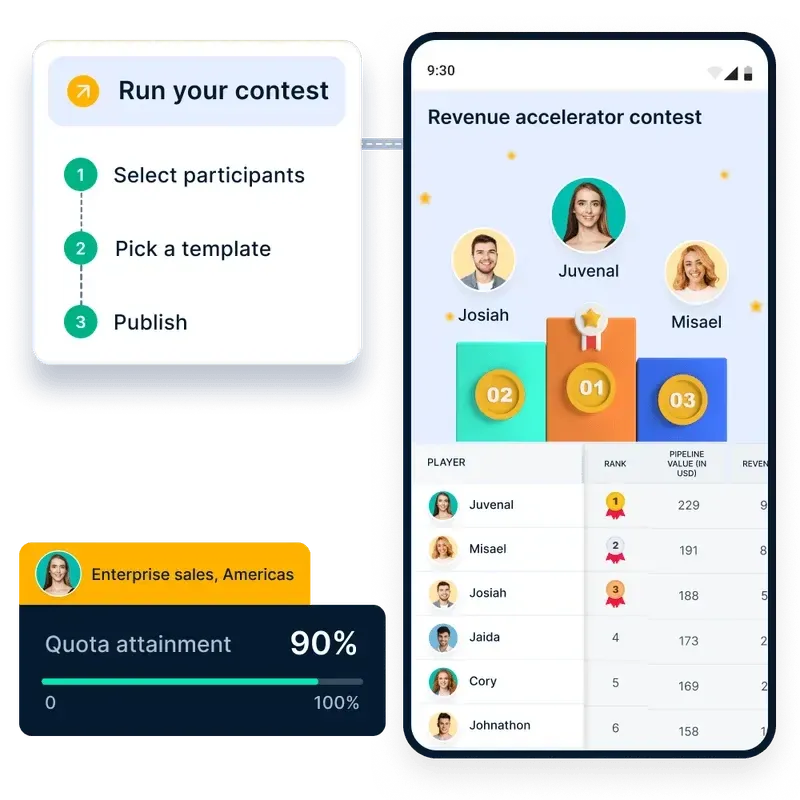
Turn Your SPIFFs into Sales-Driving Machines
Compass automates tracking, leaderboards, and payouts, ensuring your SPIFF programs drive maximum motivation and results. No manual work—just seamless execution.
Why use SPIFF in Sales?
SPIFF is used to motivate employees to perform their best. SPIFF strategy is defined in such a way that it can boost sales productivity quickly. A few reasons for the widespread use of sales SPIFF are:
1. Incentivizing engagement
The biggest worry for sales managers is motivating employees amid stress. SPIFF aims to resolve that. Any salesperson would love to achieve quick success and be rewarded immediately. Cash or non-cash SPIFFs both come in handy for this scenario.
2. Pushing sales/contract renewals
The deals that have been stuck forever but have great potential can be addressed with SPIFF incentives. You can push your sales team by devising a sales SPIFF strategy and plan specifically addressing such deals. Often, salespersons lack the enthusiasm to chase complex but potential deals due to a lack of a proper rewarding structure that is tailor-made for that.
3. Increasing brand presence and market reach
Ensuring proper market reach and establishing a dynamic brand presence aren't easy with the fiercely competitive market situation. Salespeople are the best frontrunners who can do this job perfectly and outshine the competitors, provided the right incentive is awarded after successfully achieving the goals.
4. Supporting a new product or service launch
SPIFF incentives are the best stimulant for salespersons to go on in an untapped market and gauge the potential of the product/service. Sales SPIFF stands as the motivator in their minds to strive and thrive for the success of the product/ service in an early stage.
5. Improving the dwindling sales numbers
Every organization goes through an up-and-down cycle in revenue generation, but this is one area they can't afford to be laggards. Boosting the sales numbers requires much toil and hard work from the sales team. Per the SPIFF meaning, they are rewarded handsomely if they upend the downtrend and put the growth engine in full gear.
Best sales SPIFF ideas for sales reps
Different types of sales SPIFF examples can help you find the best incentive for your team. The key is to choose ideas that resonate with your sales reps, keeping them motivated and engaged. Testing different SPIFF structures and gathering feedback will help you refine your approach for maximum impact.
While cash incentives matter, studies show that non-cash rewards can be even more effective. Exploring creative sales SPIFF examples—such as exclusive experiences, personalized gifts, or career growth opportunities—can drive long-term motivation and better results.
1. Gift cards
Probably the most common of all the non-cash incentives, gift cards are a classic way to motivate your sales team. While they might technically be in the monetary category, they’re still something tangible to give to your sales reps. Gift cards for sales reps are also very versatile. You can ask your sales reps what gift cards they want. That way, they can truly get something they want out of it.
2. Entertainment & travel
Tickets to shows, sporting events, or other experiences like fine dining or an out-of-town getaway are excellent sales SPIFF ideas. They are things that your reps might not usually spend money on. So, earning them through their hard work is rewarding and exciting! Travel vouchers like Airbnb, Makemytrip or packages and weekend getaways are also very effective. They give your sales reps something to strive for and work toward. After all, who doesn’t love a little weekend away?
3. Activities
Similar to entertainment rewards, you could organize activities for your sales team to enjoy. For example, please give them a day away from the office by sending them to the spa or out for a round of golf. These depend on what your employees enjoy the most as not everyone would like the same thing.
4. Memberships & subscriptions
Memberships are also very versatile sales SPIFF ideas, and you can customize them depending on the preferences of your team members. For example, some might love a wine club subscription, while others enjoy a gym membership.
You could also get them a subscription box. These come in categories, meaning you can personalize them to your sales rep’s tastes. HelloFresh, Skillshare, FabFitFun, and Book of the Month are popular now and usually have different subscription options. So, consider giving your sales rep a 6- or 12-month subscription to a box supporting their interests.
5. Status
Regarding status, some individuals value having a ‘better status’ than others. Mainly because it appeals to their desire to receive praise and recognition, some examples include featuring the top performer’s name on the leaderboard, inclusion in the President’s club, a better parking spot, or a displayable award or trophy.
One way to do this is through gamification. For example, making your incentives program fun and competitive with a leaderboard is a great way to motivate your sales reps. You can reward your top performers with appreciation gift cards; everyone will see their status at the top!
6. Access
Another great sales SPIFF idea is to allow your sales reps to gain access to information, support, or resources that others might not. For example, first dibs on new accounts or clients, a private calling booth, or opportunities to attend valuable training sessions that put them ahead of the competition.
However, like status SPIFFs, access isn’t without the occasional drawback. Take the following as an example: If a rep is motivated by money or status, they might feel this is a cop-out because it might come at no extra expense to the company. So, it’s best to consult with the rep to see if they want to receive this.
7. Power
You could also leverage giving a successful sales rep more power and responsibility. They can use their success to inspire change in fellow employees. Demonstrating proactive work means that such an individual would be a great role model for driving business improvements.
How do you run effective sales SPIFF programs?
SPIFF in sales is a broad-edged sword that can be cut both ways. If designed rightly, it can boost the revenue engine; otherwise, it might create uncontrollable chaos in the sales team ecosystem.
A few pointers to keep in mind while devising the spiff sales incentive program are:
1. Understand and visualize the goals properly
The entire journey of SPIFF starts with understanding the vision and defining the subsequent goals to achieve the stated vision. You need to motivate every salesperson for the SPIFF, but the goals must be set clearly. If clarity is given, it paves the way for transparency and sets the motion correctly for the sales folks.
Example: If you're handling a team of 10 sales folks, you would like $30,000 in revenue added to the top line by the third quarter.
2. Articulate how you want your reps to achieve the desired target
A successful sales team needs direction from time to time. Your reps would like to understand the know-how of the entire goal setting and how they can achieve the objective. You need to make sure everything is clear to them step by step. If you articulate and specify the goals correctly, it acts as the reference point for your team.
Example: At the end of the third quarter, you would like your SDRs to drive 50 sales-qualified leads individually from LinkedIn, and they would be rewarded $500 extra if they successfully meet the target within the deadline.
3. Establish the criteria
Probably, sales SPIFF incentives are not for anyone and everyone. You must decide who is eligible for the SPIFF and by what medium. Both pointers need to be explained to the team in clear terms.
Example: You want junior SDR (less than three years experience) to generate a pipeline with 10 interested leads each quarter. On the other hand, you want senior folks (> 3years experience) to close 5 enterprise deals in each quarter. If they meet the target, they will receive a $1000 bonus on top of their reimbursement structure.
4. Determine the incentive structure as per your team's need
SPIFF can only be effective if your salespeople desire to have it, and they feel motivated in the journey to achieve it. Therefore, you need to discuss and introduce them and see what motivates them the most - money, gift cards, or more. Once you understand their key drivers, you can have the SPIFF sales incentive tailor-made for your team's needs.
Example: Tour Group lets the employees who complete 1 year with them choose 1 all-expense-paid trip to any of the 700 destinations. These are called FAM or Familiarization trips so they can all rejuvenate and spend quality time with their family members. G Adventures will pay $3,000 for tours up to 17 days/16 nights and flights up to $750 (Source: Business Insider).
5. Define a proper timeline and allocate the budget accordingly
You must first define a timeline and pass that message along so there isn't any confusion. Also, as sales SPIFF works on the trust factor, you must stand by your promise. For example, if you define a $500 bonus for achieving 50 SQLs, you better be prepared to shell out several $500 checks if multiple employees accomplish the target.
Example: 100 SQL at the end of Q1 will attract a bonus of $1000 for anyone who achieves it.
Potential SPIFF problems and how to overcome
In the absence of a SPIFF sales incentive strategy, SPIFFs can prove to be detrimental. A few problems management encounters are:
- Sandbagging: SPIFFs are known as the element of surprise. Unpredictability drives the sales guys off their seats. But if they get to know about the upcoming sales SPIFFs, they might sandbag the deals to earn the bonus. Therefore, SPIFF incentives have to be time-bound and have a surprise element.
- Budget constraint: Once in a while, SPIFF incentives can do wonders and fit your pocket simultaneously, but having too many might burn your cash flow a lot. Limited, time-bound SPIFFs should be maintained and managed.
- Toxicity in work culture: Sales SPIFF can create internal tension amongst the top performers, and rather than cooperation in the team, there might be fierce competition regarding every lead. You need to draw the boundary on how much they will tolerate it and where the fine line ends.
Run high-impact SPIFF programs with Compass
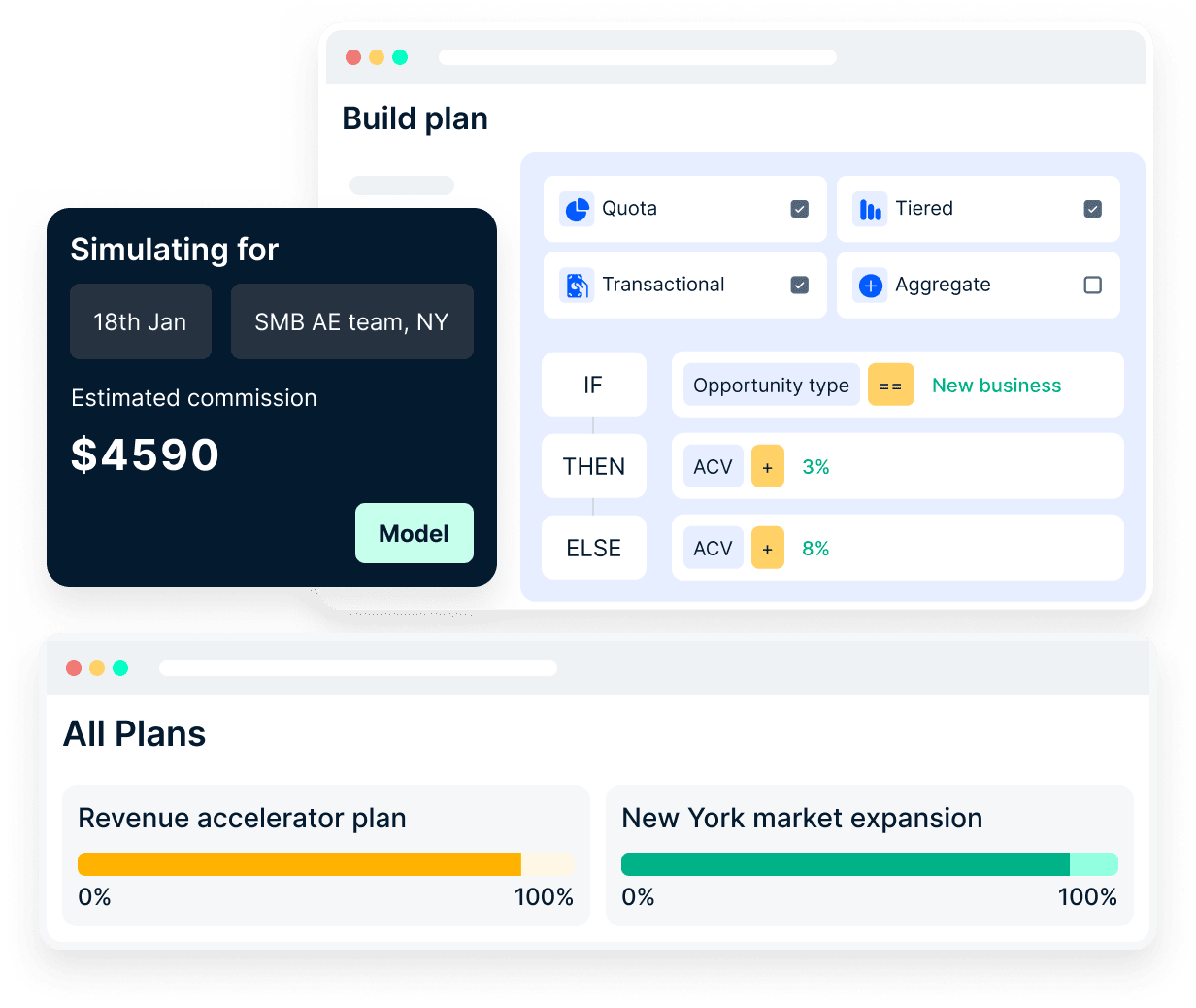
Running a successful sales SPIFF program requires more than just setting targets. Sales reps need clear visibility into their performance, real-time updates, and instant payouts to stay motivated. Compass takes the hassle out of managing SPIFFs by automating tracking, streamlining payouts, and keeping sales teams engaged.
- Automated tracking: No more manual spreadsheets. Compass tracks SPIFF performance in real time.
- Real-time leaderboards: Reps can see where they stand, fueling competition and motivation.
- Instant notifications: Keep your team updated on progress, achievements, and rewards.
- AI-powered insights: Identify trends and optimize SPIFFs for maximum impact.
- Seamless payouts: Automate commissions and rewards so sales reps get paid fast.
A well-run SPIFF program can drive incredible results—if managed correctly. Compass makes it easy to create, track, and optimize sales SPIFFs, ensuring your team stays motivated and focused.
Ready to transform your SPIFF strategy? Try Compass today.
Get creative with your sales SPIFF ideas
Engaging your sales team is essential to grow your business and revenue. Aside from the usual incentives, bonuses, and commissions, Sales SPIFFs are an incredible way to achieve this.
Being slightly unpredictable (often coupled with specific or unique products) makes them even more fun and exciting for your sales team! Whether you choose activities and incentive gift cards or status incentives through gamification, ensure you understand your team and what they respond best to for tremendous success.
If your sales reps lack motivation and their productivity is decreasing, boost them with sales spiffs.
Gamify with leaderboards, contests, badges, milestones, and rewards. Motivate your sales, channel partners, delivery, care, and gig workforce with gamification.


